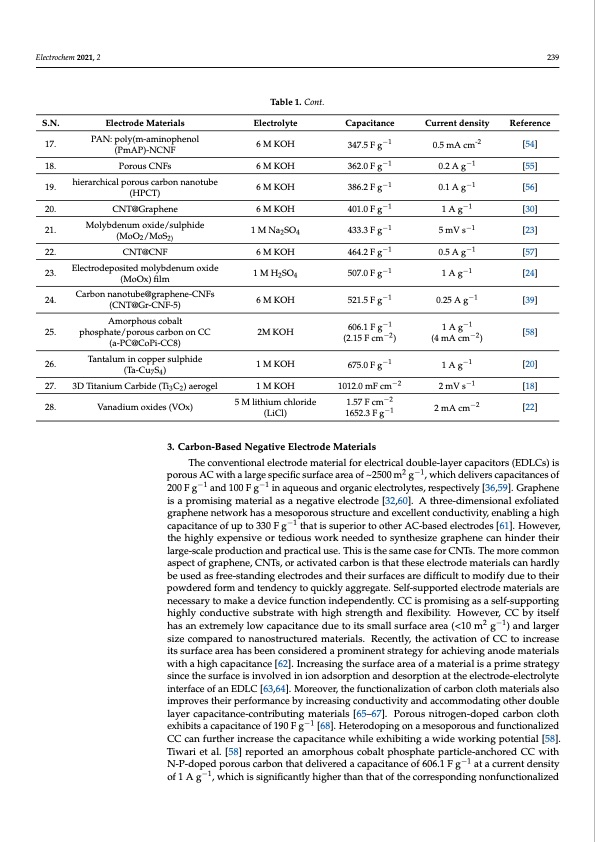
PDF Publication Title:
Text from PDF Page: 004
Electrochem 2021, 2 239 S.N. 17. 18. 19. 20. 21. 22. 23. 24. 25. 26. 27. 28. Electrode Materials PAN: poly(m-aminophenol (PmAP)-NCNF Porous CNFs hierarchical porous carbon nanotube (HPCT) CNT@Graphene Molybdenum oxide/sulphide (MoO2 /MoS2) CNT@CNF Electrodeposited molybdenum oxide (MoOx) film Carbon nanotube@graphene-CNFs (CNT@Gr-CNF-5) Amorphous cobalt phosphate/porous carbon on CC (a-PC@CoPi-CC8) Tantalum in copper sulphide (Ta-Cu7 S4 ) 3D Titanium Carbide (Ti3C2) aerogel Vanadium oxides (VOx) Table 1. Cont. Electrolyte 6MKOH 6MKOH 6MKOH 6MKOH 1 M Na2SO4 6 M KOH 1 M H2SO4 6 M KOH 2M KOH 1 M KOH 1 M KOH Capacitance 347.5 F g−1 362.0 F g−1 386.2 F g−1 401.0 F g−1 433.3 F g−1 464.2 F g−1 507.0 F g−1 521.5 F g−1 606.1 F g−1 (2.15 F cm−2) 675.0 F g−1 1012.0 mF cm−2 1.57 F cm−2 Current density 0.5 mA cm-2 0.2 A g−1 0.1 A g−1 1 A g−1 5 mV s−1 0.5 A g−1 1 A g−1 0.25 A g−1 1 A g−1 (4 mA cm−2) 1 A g−1 2 mV s−1 Reference [54] [55] [56] [30] [23] [57] [24] [39] [58] [20] [18] [22] 5 M lithium chloride (LiCl) 2 mA cm −2 1652.3 F g−1 3. Carbon-Based Negative Electrode Materials The conventional electrode material for electrical double-layer capacitors (EDLCs) is porous AC with a large specific surface area of ~2500 m2 g−1, which delivers capacitances of 200 F g−1 and 100 F g−1 in aqueous and organic electrolytes, respectively [36,59]. Graphene is a promising material as a negative electrode [32,60]. A three-dimensional exfoliated graphene network has a mesoporous structure and excellent conductivity, enabling a high capacitance of up to 330 F g−1 that is superior to other AC-based electrodes [61]. However, the highly expensive or tedious work needed to synthesize graphene can hinder their large-scale production and practical use. This is the same case for CNTs. The more common aspect of graphene, CNTs, or activated carbon is that these electrode materials can hardly be used as free-standing electrodes and their surfaces are difficult to modify due to their powdered form and tendency to quickly aggregate. Self-supported electrode materials are necessary to make a device function independently. CC is promising as a self-supporting highly conductive substrate with high strength and flexibility. However, CC by itself has an extremely low capacitance due to its small surface area (<10 m2 g−1) and larger size compared to nanostructured materials. Recently, the activation of CC to increase its surface area has been considered a prominent strategy for achieving anode materials with a high capacitance [62]. Increasing the surface area of a material is a prime strategy since the surface is involved in ion adsorption and desorption at the electrode-electrolyte interface of an EDLC [63,64]. Moreover, the functionalization of carbon cloth materials also improves their performance by increasing conductivity and accommodating other double layer capacitance-contributing materials [65–67]. Porous nitrogen-doped carbon cloth exhibits a capacitance of 190 F g−1 [68]. Heterodoping on a mesoporous and functionalized CC can further increase the capacitance while exhibiting a wide working potential [58]. Tiwari et al. [58] reported an amorphous cobalt phosphate particle-anchored CC with N-P-doped porous carbon that delivered a capacitance of 606.1 F g−1 at a current density of 1 A g−1, which is significantly higher than that of the corresponding nonfunctionalizedPDF Image | Review of Electrospun Carbon Nanofiber-Based Negative Electrode Materials

PDF Search Title:
Review of Electrospun Carbon Nanofiber-Based Negative Electrode MaterialsOriginal File Name Searched:
A_Review_of_Electrospun_Carbon_Nanofiber-Based_Neg.pdfDIY PDF Search: Google It | Yahoo | Bing
Sulfur Deposition on Carbon Nanofibers using Supercritical CO2 Sulfur Deposition on Carbon Nanofibers using Supercritical CO2. Gamma sulfur also known as mother of pearl sulfur and nacreous sulfur... More Info
CO2 Organic Rankine Cycle Experimenter Platform The supercritical CO2 phase change system is both a heat pump and organic rankine cycle which can be used for those purposes and as a supercritical extractor for advanced subcritical and supercritical extraction technology. Uses include producing nanoparticles, precious metal CO2 extraction, lithium battery recycling, and other applications... More Info
| CONTACT TEL: 608-238-6001 Email: greg@infinityturbine.com | RSS | AMP |